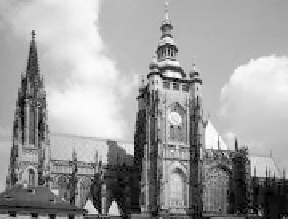Travel Reference
In-Depth Information
the Catholic Church in Prague
In stark contrast to Poland, the powerful Catholic Church—
traditionally closely allied with the Habsburgs and Austria—
was never the favorite institution
of the freedom-loving Czechs.
Th e co m m u n is t s to o k a dva nt a g e
of this popular sentiment, and in
their Marxist zeal did everything
short of banning the Church
to uproot the faith of the rela-
tively few practicing Catholics.
In the early 1950s, most monks
and priests, including the arch-
bishop, were arrested and sent
to prisons, from which they were
not released until the thawing that came with the Khrushchev
era. A wise old priest remembers his 13 years in a labor camp
as “a fascinating, well-spent time in the company of some
truly great minds.”
During the communist era, Church property was con-
fiscated, churches quickly deteriorated, churchgoers were
persecuted, and many priests had to become confidants of
the secret police in order to continue their service. Ironically,
by persecuting Catholics, the communists gave the Church
the opportunity to improve its reputation with the Czechs.
In the 1980s, the charismatic archbishop of Prague, Cardinal
Tomášek, became a local hero by frequently standing up to
the regime. By 1989, Tomášek was a main symbol of anti-
communist opposition (along with Václav Havel).
After 1989, many Czechs returned to the Catholic faith.
The trend peaked in 1992 when Tomášek died (he's now bur-
ied under the Mucha window in St. Vitus Cathedral). Since
then, the Church's hold has steadily declined, for various
reasons. The media depict the Church as greedy; questions
have arisen about the status of former Church property (see
sidebar on page 108); and the new archbishop—named Vlk
(Wolf), which his critics find fitting—is uninspiring.
These days, “new” and fashionable spiritual movements,
such as Buddhism, are drawing Czechs in increasing numbers.
The Dalai Lama has been Prague's frequent visitor.
Spire:
You can climb 287 steps up the spire for one of the best
views of the whole city (April-Oct daily 9:00-17:00 except Sun
morning, last entry 45 minutes before closing, Nov-March closes
at 16:00).
Back Outside the Cathedral:
Leaving the cathedral, turn
left (past the public WC). The
obelisk
was erected in 1928—a
single piece of granite celebrating the 10th anniversary of the




















